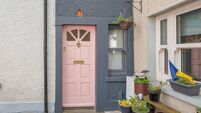Going Aloft
Most of us would admit to simply parking our boxes of headless Barbies and shattered thermos flasks that we can't bear to throw out a few inches inside the attic door before scaling back down the wobbling stepladder to domestic civilization.
In London, where house prices might someday become as expensive as somewhere as sophisticated as Dublin, house owners in period terraces East and West are moving up rather than moving out.
Materials and manpower are delivered by crane from outside the building, allowing the family to live reasonably undisturbed but for the swooping booms and cradles outside the windows. Another habitable floor for the region of £50,000 Sterling seems reasonable set against the nightmare of moving on in search of another 600 square feet.
Most estimates agree that another 10% on an overall build budget dedicated to a living loft can add up to 25% more floor space to a standard house. Planning a home, you should have an eye on the future, and give the dimensions and ground plan room for logical, economic manouvre. The cost saving can be considerable and, if you do sell, the development potential clearly inherent in the house will certainly be attractive to another buyer. Plumbing for an ensuite can be allowed for in an attic space. Power lines and telephone cables can be set in place even if all you need for now is a naked bulb. The dimensions of the roof and the method of its construction are critical, and herein lies the extra expense.
Obviously, the steeper the pitch, the more space there will be in which to stand up, though it constantly amazes me how clever interior detailing can utilize even very low head room.
Modern attic rafters or traditional rafter and purlin construction will get you out of the forest of crossed members typical in a post 1960s house. Your dormer windows or in-line roof lights should be represented on your detailed plans for planning permission, as it's largely the exterior elevations that interest the planning officers.
The stairs is a rather tricky matter, as you will probably want to use only a fraction of space if the loft is extra square footage rather than your primary living quarters. Spiral staircases are one solution, though not very user-friendly. Ensure you can get out safely in the event of fire or any other emergency. If you are building afresh, the building regulations will insist that you take these precautions in any case.
If you have an existing home with a highly desirable pre-1960s "cut roof", a conversion overhead could provide attractive space without altering the footprint of the house.
Before you decide, are you really sure that there is enough headroom and sufficient access to create a convenient new room overhead? Is the sacrificed square footage necessary to create a staircase almost the same as the headroom you are gaining? Will you need planning permission? If you pierce the roof or gable with a new window, and you will need windows both for light and as a means of escape in the event of fire, you must apply for planning permission. If the windows are in line with the roof and placed on the back of the house, permission is generally not required.
A quality conversion utilising a suspended floor that will reduce impact noise to the floor below, together with a complete staircase as access, will cost in the region of €15,000 for an average sized home. There are a number of specialist companies offering this exclusive service and many builders can also handle the job.
Velux-style windows are a common approach to the challenge of introducing extra light without seriously altering the roof's character with a dormer structure. Prices start at €200 for a Velux Budget GRL Rooflight of 78X98cm, rising to well over €2,500 for a large Velux Cabrio Balcony System that can flip open into a small terrace.
Pulling a loft ladder up and down (€180-€240 installation) might suit the more athletic homeowner, but a real stair is a better investment if you can make room for it.
You will probably need more than one window to introduce the recommended glazing to floor area of 10-20%. If you intend to use your attic room as an office, have your electrician run some CAT 5 cables up to the space to allow you to integrate your home networking needs for the future. Ensure your quote includes rooflights, the flooring structure, dry lining, insulation, ventilation requirements, all electrics, plumbing (if you need a bathroom upstairs) and the means of access.
This type of renovation will probably not re-coup its value by the square yard, but it does add some unpredictable value and it may accelerate a sale by rendering the house more desirable.
If you sell, you cannot describe the loft space as an extra bedroom (even if you use it as one), but obviously any extra square footage will attract interest.












